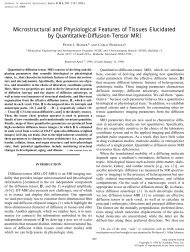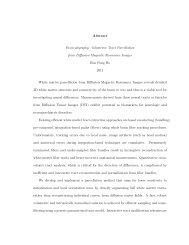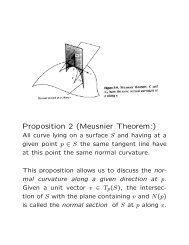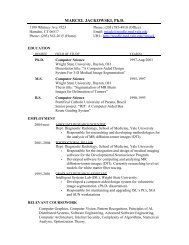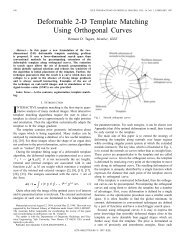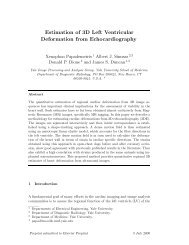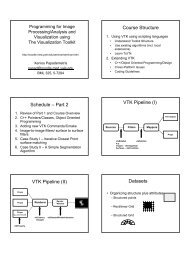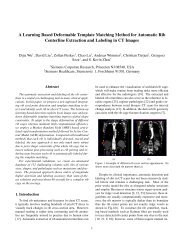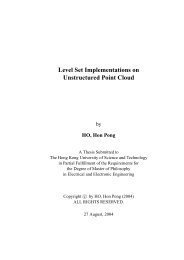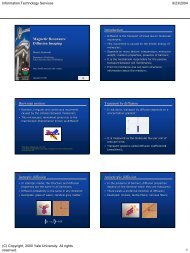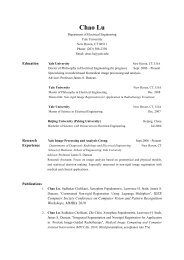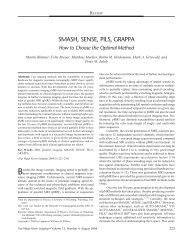Pulsed-field gradient nuclear magnetic resonance as a tool for ...
Pulsed-field gradient nuclear magnetic resonance as a tool for ...
Pulsed-field gradient nuclear magnetic resonance as a tool for ...
You also want an ePaper? Increase the reach of your titles
YUMPU automatically turns print PDFs into web optimized ePapers that Google loves.
318<br />
PRICE<br />
probability of a spin starting from r 0 and moving<br />
to r in time is given by Žrecall Eq. 24. 1<br />
Ž . Ž . <br />
r P r ,r , . 73<br />
0 0 1<br />
The NMR signal is proportional to the vector<br />
sum of the transverse components of the magnetization,<br />
and so the signal from one spin is given<br />
by<br />
Ž . Ž . igŽr 1r 0. <br />
r P r ,r , e . 74<br />
0 0 1<br />
But in NMR, the signal results from the ensemble<br />
of spins, and thus we must integrate over all<br />
possible starting and finishing positions, and finally<br />
we arrive at our result Ž 55, 56.<br />
EŽ g,. HH Ž r . PŽ r ,r ,.<br />
0 0 1<br />
igŽr e 1r0. dr dr . 75 0 1<br />
Thus, the total signal is a superposition of signals<br />
Ž transverse magnetizations . , in which each ph<strong>as</strong>e<br />
term is weighted by the probability <strong>for</strong> a spin to<br />
begin at r 0 and move to r1 during .<br />
As an example, let us rederive Eq. 51 using<br />
the SGP approximation Ži.e., Eq. 75 . . From Eq.<br />
75 and 27 ,<br />
we have<br />
1 2<br />
Žr 1r 0.<br />
4 D<br />
HH 0 32<br />
EŽ g,. Ž r .<br />
e<br />
Ž 4D.<br />
igŽr 1r 0. <br />
e dr dr . 76<br />
1 0<br />
In the present c<strong>as</strong>e, we set g g Ž z we will drop<br />
the subscript z, however . , and R r1r 0.Us-<br />
ing spherical polar coordinates Ži.e.,<br />
R is the<br />
radius and and are the polar and azimuthal<br />
angles, respectively . , we note that dR <br />
R2 sin dR d d; also, since is the angle between<br />
R and g we have<br />
1 2 2 R 4 D 2<br />
32<br />
H H<br />
EŽ g,. <br />
Ž 4D.<br />
0<br />
d<br />
0<br />
e R<br />
igR cos H e sin d dR<br />
0<br />
77 As there is no dependence, it can be integrated<br />
out<br />
2 2 R 4 D 2<br />
e R<br />
32<br />
H<br />
Ž 4D.<br />
0<br />
igR cos H e sin d dR<br />
0<br />
78 then, by noting that d cos sin d, we get<br />
2 2<br />
1<br />
R 4 D 2 igR<br />
32H<br />
H<br />
Ž . 0 1<br />
4D<br />
e R e d dR.<br />
<br />
79<br />
The integral over is then per<strong>for</strong>med and evalu-<br />
<br />
ated using Eq. 11 , resulting in<br />
4 <br />
2 R 4 D Ž .<br />
32<br />
H<br />
g Ž 4D.<br />
0<br />
Re sin gR dR<br />
<br />
80<br />
We note from a table of standard integrals e.g.,<br />
Ž 53. Eq. 3.952 1. that<br />
2 2 a 2 2<br />
p x Ž . a 4p<br />
xe sin ax dx e . 81 4p<br />
'<br />
H 3<br />
0<br />
Ž . 12<br />
In our c<strong>as</strong>e, x R, p 4D , and a g,<br />
and thus we obtain the final result<br />
Ž . Ž 2 2 2 . <br />
E g, exp g D . 82<br />
This is the same <strong>as</strong> Eq. 51 ,<br />
but in the limit of<br />
0; thus the 3 term which accounts <strong>for</strong> the<br />
finite width of the <strong>gradient</strong> pulse is absent. When<br />
we consider restricted diffusion, the evaluation of<br />
Eq. 75 proceeds in exactly the same manner,<br />
except that we must substitute the relevant Ž r . 0<br />
and PŽ r , r , t . 0 1 . However, <strong>as</strong> the confining geometry<br />
becomes more complicated, so does the<br />
mathematical complexity.<br />
The Analogy between PFG Me<strong>as</strong>urements and Scattering.<br />
Returning back to the derivation of the<br />
SGP approximation, and in particular, Eq. 72 ,<br />
because we are using a constant Žcommonly<br />
termed ‘‘linear’’ . <strong>gradient</strong>, what is important is<br />
not the actual starting and finishing positions of<br />
the spin but the net displacement between the<br />
two points in the direction of the <strong>gradient</strong>. As<br />
be<strong>for</strong>e, we can write R r1r0 and, analogously<br />
to Eq. 73 ,<br />
the probability that a particle<br />
that starts at r 0 displacing a distance R during <br />
is given by Žrecall Eq. 24. Ž . Ž . <br />
r P r ,r R, . 83<br />
0 0 0



